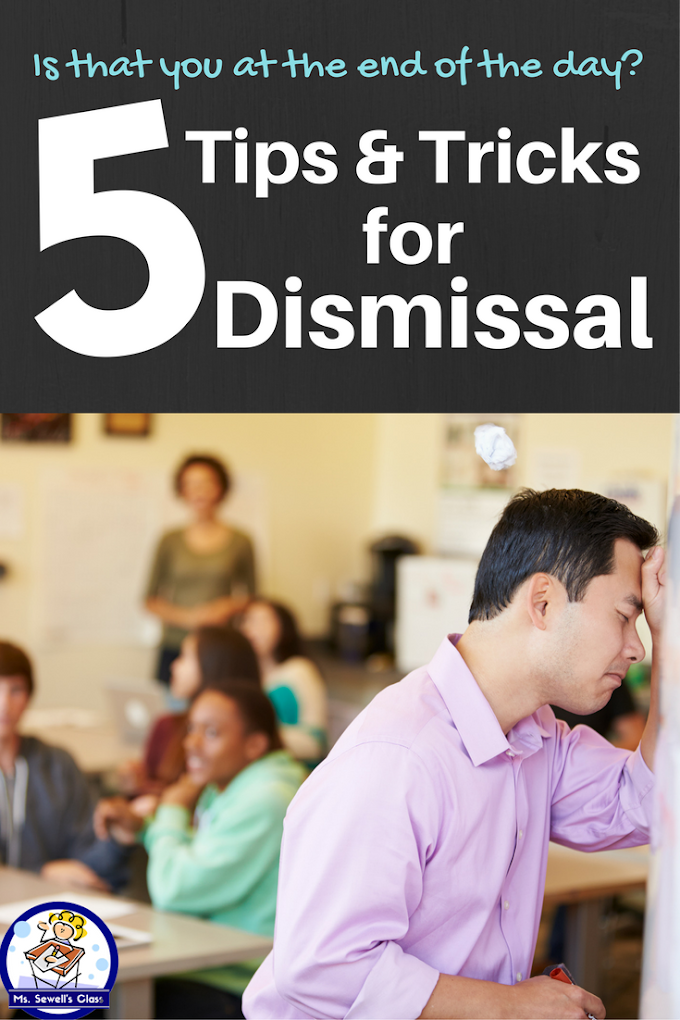 |
| How I definitely look leaving school Image taken from http://bit.ly/2d4a4EK |
 |
| How I imagine come to school |
Every school year, I spend hour upon hour planning for every minute, but when the end of the day comes, it's like I forgot it was going to happen. Chaos ensues while there is still so much I need to accomplish like checking agendas, helping students pack-up, taking calls from the office, conferring with my behavior issues, and planning where I'll go for happy hour after I make it
1. Get the Room Clean
An easy strategy is to assign a certain number of pieces of trash or items to pick up for each student. If the room's relatively clean, everyone could throw away/put away 5 pieces. If the room looks like a sonic boom hit, it could be 30 pieces.
In the beginning, I really monitored that each student was helping, making them think I would be watching them that closely all the time. And when I found kids ripping up paper and counting out 30 pieces to throw away, the amount they would have to find would double. Students needed to know everyone was responsible for helping, and I found having a tangible number made it more concrete.
A phenomenal idea I learned from a phenomenal primary teacher was to tell the kids that each afternoon you see a piece of "magic trash." Whoever finds it as they clean up is the winner that day. Oddly enough, the "magic trash" doesn't get picked up until the very end of cleaning time. Are you with me on this one? Genius!
 |
| How I'd Want My Room to Look at the End of the Day |
 |
| How My Room Would Actually Look at the End of the Day |
2. Silent Speed Ball
Have a very active class? Yea, I always do too. After students complete all their end of day tasks, you could teach them how to play Silent Speedball. Students sit in a circle with a ball. They have to pass the ball around the circle, in no particular order, but the big rule is they can't talk. They have to figure out a way to keep the ball off the ground, without using verbal cues. If they're ready for an extra challenge, they have to pass as fast as possible. No one is ever out, so if someone drops it, the game just starts over. It's the game that keeps on giving.
Depending on your class size, you could have a few small groups playing or as a challenge, a whole class competition.
3. Choice Boards
 |
| End of Day Choice Board Example |
I've created a set of weekly choice boards with motivating activities for the end of the day. You can check it out here. Want to test drive the choice boards before buying? Get a free weekly board to try out here!
4. Journaling
I've had a lot of success with journaling at the end of the day. With one particularly hard to manage class, they wrote reflection journals. In a reflection journal, students could write about anything that was on their mind at the end of the day. Then, if they wanted me to read their entry because they needed help with an issue or another student, they could leave the journals on their desk and I would write a quick note back or talk to them the next day. If they wrote something private they did not want me to read, they put their journals away.
Did I still read them even if they put them away somedays? Of course, especially if I noticed something was off with a student or we were having a management issue. But I would never reference the journal information unless they had allowed me to read it. I was surprised at the outlet it provided for some of my most difficult students, as well as my quietest.
You could also have students journal about academic topics, but I've found that creative prompts will keep them more engaged. One of my favorite sets of writing prompts is by Rachel Lynette and can be found here. My class loved them and they really get the creative juices flowing!
5. Choices
As I mentioned earlier in this post, choice is a powerful motivator. You could have a few quiet activities set up that students could pick from. Some ideas I've tried and had success with in the past are:
- Read or Partner Read Quietly
Partner Reading - Free Write (something about adding "free" to the beginning is motivating)
- Brain Teasers (those Brainquest cards are perfect for this time)
- Draw (they'll jump for joy if you let them draw on whiteboards)
- Academic Computer or iPad Games
- Show an Academic Video (Brainpop has some great free ones)
- Clean Out Your Desk or Bookbag
- Chat Quietly with a Friend
- Learn/Practice Sign Language Letters (This site has some wonderful resources/apps and bonus, your class will learn to communicate silently!)
- Scrabble
- Card Games
If you're giving choices, be clear on your expectation that they need to be cleaned up when students are done or they are no longer an option for a time. You may even want to practice how to clean up so that students know exactly what to do. The more practice before the stressful time that is the end of the day, the better.
For these to be successful, it's also good to have a "non-choice" ready for students who can't work quietly or become disruptive. Maybe it's a packet of boring worksheets that you can give them or it involves writing an apology letter to you. Whatever you choose, have a back-up. You'll probably only need to use it a few times before the student realizes they'd rather make their own choice.
For these to be successful, it's also good to have a "non-choice" ready for students who can't work quietly or become disruptive. Maybe it's a packet of boring worksheets that you can give them or it involves writing an apology letter to you. Whatever you choose, have a back-up. You'll probably only need to use it a few times before the student realizes they'd rather make their own choice.
What tips and tricks do you have to make the end of the day easy peasy?









0 Comments